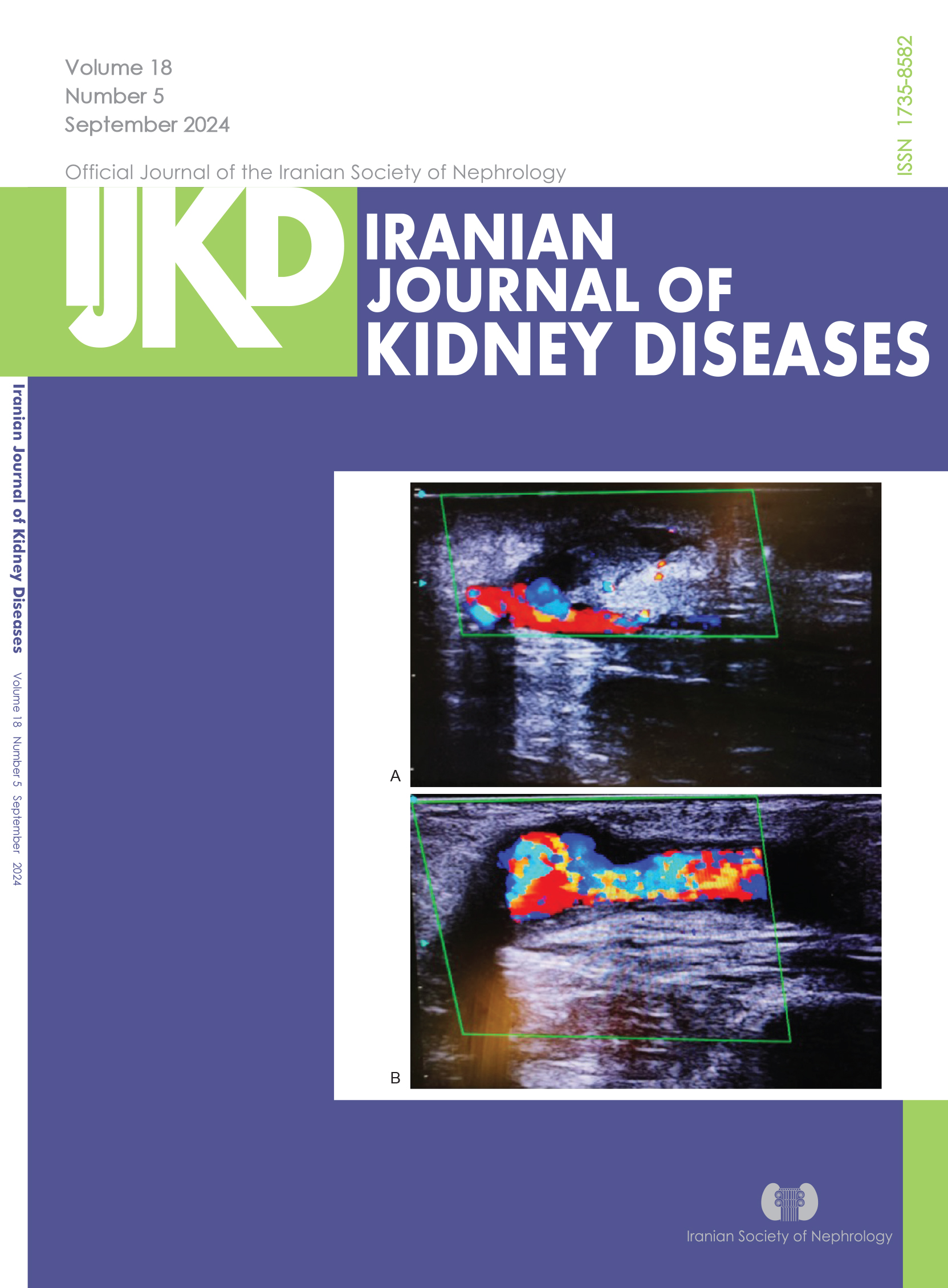Establishing a Risk Model for Diabetic Nephropathy and Addressing the Therapeutic Effect of Combined Epalrestat- Dapagliflozin Regimen
DOI:
https://doi.org/10.52547/ax1vqh41Keywords:
Diabetic nephropathy, Prediction model, Epalrestat, Dapagliflozin, Clinical efficacyAbstract
Introduction. To explore the construction of a diagnostic prediction model of diabetic nephropathy (DN) in type 2 diabetic patients for prognostic risk prediction and observe the therapeutic effect of Epalrestat combined with Dapagliflozin on DN.
Methods. The study consisted of two phases, phase I: A retrospective analysis was conducted on the case information and clinical treatment related data of a total of 460 patients who underwent kidney biopsy from June 2018 to June 2021. They were randomly divided into validation queue and training queue. The predictive factors of the diagnostic prediction model were obtained through multivariate logistic regression. Phase II: An interventional study of 94 patients with DN admitted between January 2022 and August 2023 was conducted, and they were randomized into a control group (n = 47) receiving Dapagliflozin and a research group (n = 47) receiving Epalrestat combined with Dapagliflozin. The glucose metabolism, renal function, and treatment safety of the two groups before and after treatment were compared. In addition, the adverse reactions during the treatment of the two groups were counted.
Results. In the phase I of the study, the DN risk model established showed a good performance in the diagnosis and risk assessment of patients with DN and could provide certain reference opinions for future clinical practice. In the phase II of the study, the research group showed better glucose metabolism and renal function than the control group after treatment (P < .05), but no statistical difference was identified between groups in the incidence of adverse reactions (P > .05).
Conclusion. Epalrestat combined with Dapagliflozin is significantly effective in the treatment of DN, which can effectively improve glucose metabolism and renal function in DN patients.
Downloads
References
1. Jia HM, Jiang YJ, Zheng X, et al. The attributable mortality of sepsis for acute kidney injury: a propensity-matched analysis based on multicenter prospective cohort study. Ren Fail. 2023;45(1):2162415. doi:10.1080/088602
2X.2022.2162415
2. Chen S, Kuang M, Qu Y, et al. Expression of Serum Cytokines Profile in Neonatal Sepsis. Infect Drug Resist. 2022;15:3437-3445. doi: 10.2147/IDR.S368772.
3. Singer M, Deutschman CS, Seymour CW, et al. The Third International Consensus Definitions for Sepsis and Septic Shock (Sepsis-3). JAMA. 2016;315(8):801-810. doi:10.1001/jama.2016.0287
4. Uchino S, Kellum JA, Bellomo R, et al. Acute renal failure in critically ill patients: a multinational, multicenter study. JAMA. 2005;294(7):813-818. doi:10.1001/jama.294.7.813
5. Hoste EA, Bagshaw SM, Bellomo R, et al. Epidemiology of acute kidney injury in critically ill patients: the multinational AKI-EPI study. Intensive Care Med.
2015;41(8):1411-1423. doi:10.1007/s00134-015-3934-7
6. Meersch M, Küllmar M, Schmidt C, et al. Long-Term Clinical Outcomes after Early Initiation of RRT in Critically Ill Patients with AKI. J Am Soc Nephrol. 2018;29(3):1011-1019. doi:10.1681/ASN.2017060694
7. Jiang X, Liu Y, Ma L, et al. Chemopreventive activity of sulforaphane. Drug Des Devel Ther. 2018;12:2905-2913. Published 2018 Sep 11. doi:10.2147/DDDT.S100534
8. Dennis JM, Witting PK. Protective Role for Antioxidants in Acute Kidney Disease. Nutrients. 2017;9(7):718. Published 2017 Jul 7. doi:10.3390/nu9070718
9. Basak P, Sadhukhan P, Sarkar P, Sil PC. Perspectives of the Nrf-2 signaling pathway in cancer progression and therapy. Toxicol Rep. 2017;4:306-318. Published 2017 Jun 13. doi:10.1016/j.toxrep.2017.06.002
10. Liu P, Atkinson SJ, Akbareian SE, et al. Sulforaphane exerts anti-angiogenesis effects against hepatocellular carcinoma through inhibition of STAT3/HIF-1α/VEGF signalling. Sci Rep. 2017;7(1):12651. Published 2017 Oct 4. doi:10.1038/s41598-017-12855-w
11. Ranaweera SS, Dissanayake CY, Natraj P, Lee YJ, Han CH. Anti-inflammatory effect of sulforaphane on LPS-stimulated RAW 264.7 cells and ob/ob mice. J Vet Sci. 2020;21(6):e91. doi:10.4142/jvs.2020.21.e91
12. Pearson BL, Simon JM, McCoy ES, Salazar G, Fragola G, Zylka MJ. Identification of chemicals that mimic transcriptional changes associated with autism, brain aging and neurodegeneration. Nat Commun. 2016;7:11173. Published 2016 Mar 31. doi:10.1038/ncomms11173
13. Wu W, Peng G, Yang F, Zhang Y, Mu Z, Han X. Sulforaphane has a therapeutic effect in an atopic dermatitis murine model and activates the Nrf2/HO-1 axis. Mol Med Rep. 2019;20(2):1761-1771. doi:10.3892/mmr.2019.10405
14. Oh CJ, Kim JY, Min AK, et al. Sulforaphane attenuates hepatic fibrosis via NF-E2-related factor 2-mediated inhibition of transforming growth factor-β/Smad signaling. Free Radic Biol Med. 2012;52(3):671-682. doi:10.1016/j. freeradbiomed.2011.11.012
15. Bao B, Zhang MQ, Chen ZY, et al. Sulforaphane prevents PC12 cells from oxidative damage via the Nrf2 pathway. Mol Med Rep. 2019;19(6):4890-4896. doi:10.3892/
mmr.2019.10148
16. Zhao B, Gao W, Gao X, et al. Sulforaphane attenuates acute lung injury by inhibiting oxidative stress via Nrf2/HO-1 pathway in a rat sepsis model. Int J Clin Exp Pathol. 2017;10(8):9021-9028. Published 2017 Aug 1.
17. Tang Y, Yang X, Shu H, et al. Bioinformatic analysis identifies potential biomarkers and therapeutic targets of septic-shock-associated acute kidney injury. Hereditas. 2021;158(1):13. Published 2021 Apr 16. doi:10.1186/s41065-021-00176-y
18. Luo S, Gong J, Zhao S, Li M, Li R. Deubiquitinase BAP1 regulates stability of BRCA1 protein and inactivates the NF-κB signaling to protect mice from sepsis-induced acute kidney injury. Chem Biol Interact. 2023;382:110621. doi:10.1016/j.cbi.2023.110621
19. Guo J, Zhang W, Liang P, et al. Nan Fang Yi Ke Da
Xue Xue Bao. 2023;43(7):1248-1253. doi:10.12122/j. issn.1673-4254.2023.07.22
20. Zhang J, Chen Q, Dai Z, Pan H. miR-22 alleviates sepsis-induced acute kidney injury via targeting the HMGB1/TLR4/NF-κB signaling pathway. Int Urol Nephrol. 2023;55(2):409-421. doi:10.1007/s11255-022-03321-2
21. Fusi L, Paudel R, Meder K, et al. Interaction of transcription factor FoxO3 with histone acetyltransferase complex subunit TRRAP modulates gene expression and apoptosis. J Biol Chem. 2022;298(3):101714.
doi:10.1016/j.jbc.2022.101714
22. Lou D, Xing X, Liang Y. Dendrobine modulates autophagy to alleviate ox-LDL-induced oxidative stress and senescence in HUVECs. Drug Dev Res. 2022;83(5):1125-1137. doi:10.1002/ddr.21937


